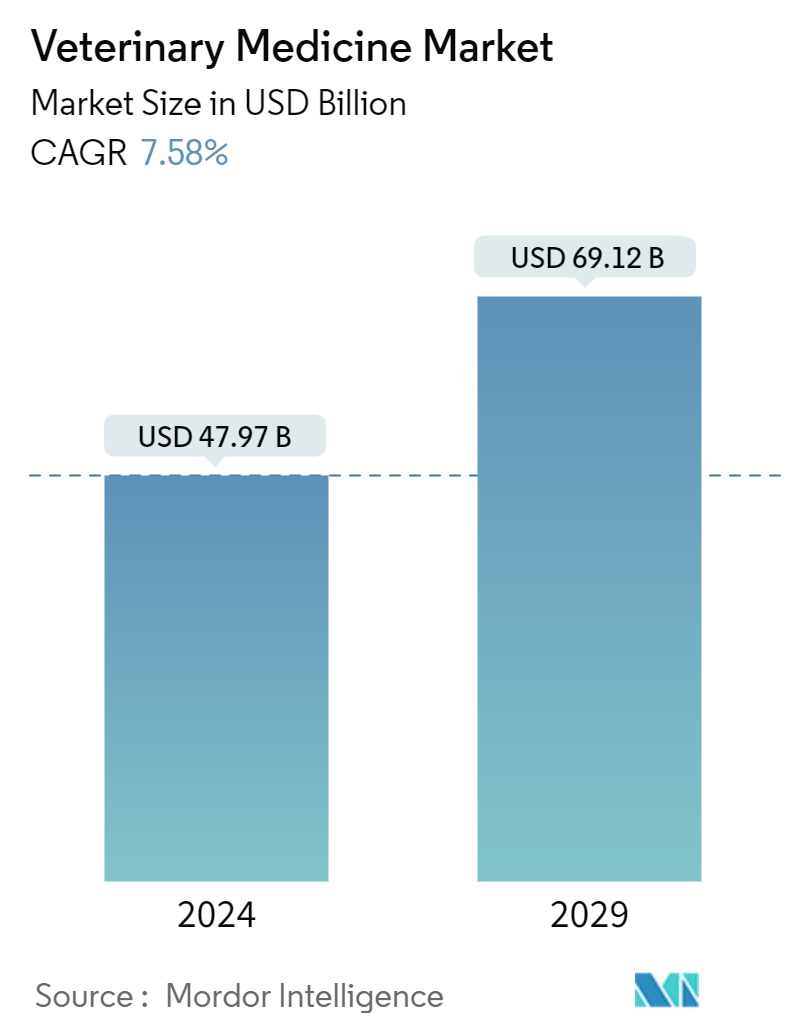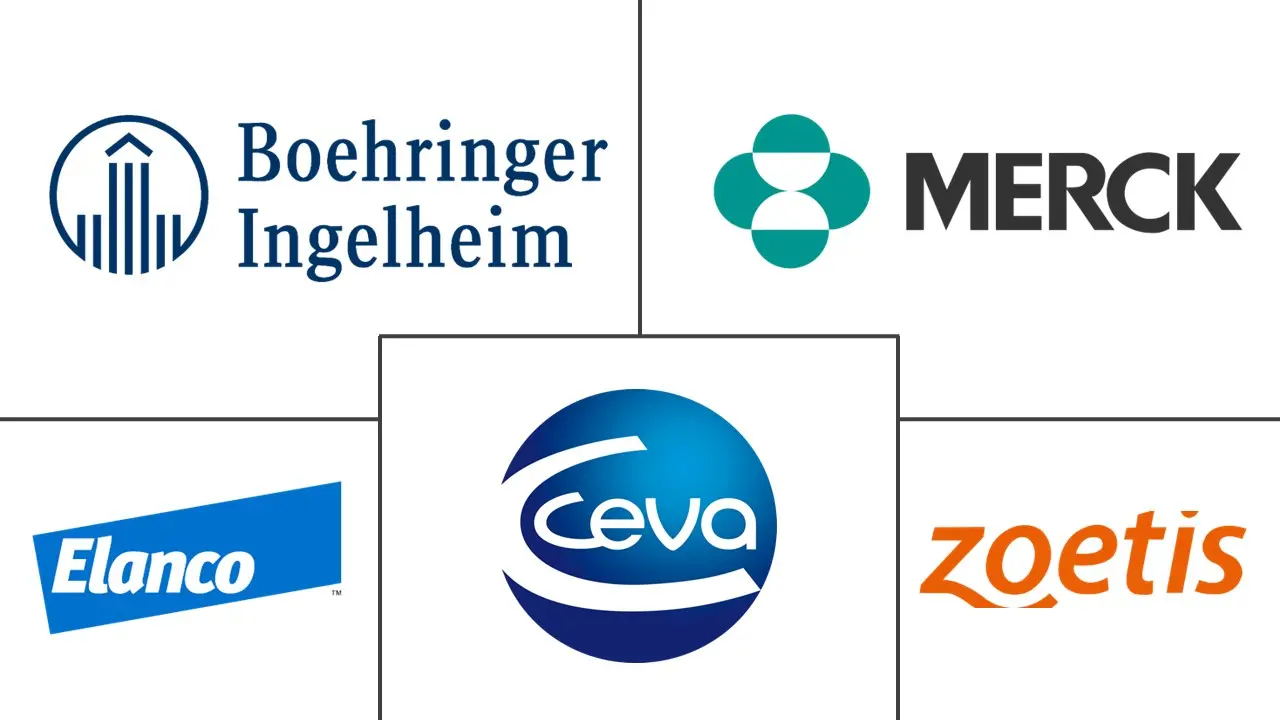Market Size of Veterinary Medicine Industry

| Study Period | 2019 - 2029 |
| Market Size (2024) | USD 47.97 Billion |
| Market Size (2029) | USD 69.12 Billion |
| CAGR (2024 - 2029) | 7.58 % |
| Fastest Growing Market | Asia Pacific |
| Largest Market | North America |
Major Players
*Disclaimer: Major Players sorted in no particular order |
Veterinary Medicine Market Analysis
The Veterinary Medicine Market size is estimated at USD 47.97 billion in 2024, and is expected to reach USD 69.12 billion by 2029, at a CAGR of 7.58% during the forecast period (2024-2029).
Megatrends and Macro Growth Drivers: The Veterinary Medicine Market is witnessing substantial expansion, propelled by several critical megatrends. Chief among these is the increasing humanization of pets, which elevates the importance of pet healthcare, along with a growing awareness of animal health. Rising demand for animal-derived products—both in agriculture and human healthcare—further drives this market. These factors are supported by additional growth drivers such as the increasing burden of chronic diseases in animals, a shift toward pharmaceutical interventions by pet and poultry farm owners, and a heightened demand for meat and other animal-based products.
Growing Burden of Chronic Disease Conditions in Animals, Coupled with the Increasing Adoption of Animals: Chronic diseases in companion animals are becoming more prevalent, with one in four dogs now expected to be diagnosed with cancer during their lifetime. Conditions like osteoarthritis affect an estimated 20% of dogs older than one year. This increase in chronic conditions aligns with a growing rate of pet ownership. In the U.S., approximately 70% of households own a pet, further driving the demand for veterinary pharmaceuticals, diagnostics, and treatments. Pet owners, concerned with the health and longevity of their pets, are actively seeking advanced animal healthcare products.
Increase in Drug Preferences by Pet and Poultry Farm Owners: Pet owners and poultry farmers are increasingly turning to pharmaceutical solutions for treating both infectious and chronic diseases. Non-steroidal anti-inflammatory drugs (NSAIDs) are widely used to manage osteoarthritis in dogs, while glucocorticoids are becoming more common in treating chronic respiratory conditions in companion animals. In poultry farming, systemic ectoparasitic drugs like fluralaner are preferred for addressing infestations. This shift towards pharmaceutical interventions for animal disease treatment is spurring growth in the veterinary drug market, especially in sectors focusing on livestock health management and pet medication.
Increased Demand for Meat and Animal-based Products in Agriculture and Human Healthcare: The global demand for meat is on the rise, with beef and veal consumption projected to reach 76,386 kt cwe by 2031, according to the OECD-FAO Agricultural Outlook Report. Similarly, pig meat consumption is expected to grow by over 18,000 kt cwe in the same period. This growth demands healthier livestock, which fuels the need for veterinary healthcare products, including vaccines and nutritional supplements. The rise of animal-derived products in human healthcare, such as pharmaceuticals like enoxaparin and lactose, also underscores the importance of maintaining animal health to meet industry needs.
Veterinary Medicine Industry Segmentation
As per the scope of the report, veterinary drugs are used by veterinary professionals to treat diseases and injuries and help to promote growth in animals. These are majorly used to cure diseases and prevent the spread of infectious diseases among animals. These drugs indirectly benefit human healthcare by restricting the spread of infectious diseases from animals to humans.
The market is segmented by product type, animal type, and geography. By Product Type, the market is segmented into drugs, vaccines, and medicated feed additives. By drugs, the market is segmented into anti-infectives, anti-inflammatory, parasiticides, and other drugs. By vaccines, the market is segmented into inactive vaccines, attenuated vaccines, recombinant vaccines, and other vaccines. By medicated feed additives, the market is segmented into amino acids, antibiotics, and other medicated feed additives. By animal type, the market is segmented into companion animals and livestock animals. By companion animals, the market is segmented into dogs, cats, and other companion animals. By livestock animals, the market is segmented into cattle, poultry, swine, sheep, and other livestock animals. By geography, the market is North America, Europe, Asia-Pacific, Middle East and Africa, and South America.
The market report also covers the estimated market sizes and trends for 17 different countries across major regions globally. The report offers the value (in USD) for the above segments.
| By Product Type | ||||||
| ||||||
| ||||||
|
| By Animal Type | |||||||
| |||||||
|
| By Geography | ||||||||
| ||||||||
| ||||||||
| ||||||||
| ||||||||
|
Veterinary Medicine Market Size Summary
The veterinary medicine market is poised for significant growth over the forecast period, driven by several key factors. The increasing burden of chronic diseases among animals, coupled with a rise in pet adoption and the growing demand for animal-based products, is propelling the market forward. The COVID-19 pandemic initially disrupted the industry, affecting supply chains and animal product distribution. However, as restrictions eased, the market began to recover, with a notable increase in pet ownership positively impacting the demand for veterinary services. The surge in the global livestock population and the prevalence of zoonotic diseases further contribute to the market's expansion. Additionally, ongoing research and development, along with advancements in veterinary pharmaceuticals and vaccines, are expected to bolster market growth.
North America is anticipated to hold a significant share of the veterinary medicine market, supported by favorable reimbursement programs and increased spending on companion animals. The region's pet ownership rates and awareness of animal health issues are on the rise, driving demand for veterinary care. Key market players, including Zoetis, Boehringer Ingelheim, and Elanco, are actively engaged in strategic developments and product launches, enhancing their competitive positions. Despite the high costs associated with animal healthcare and limited awareness in emerging markets, the overall market landscape remains moderately fragmented, with ongoing consolidations likely to intensify competition among major players.
Veterinary Medicine Market Size - Table of Contents
-
1. MARKET DYNAMICS
-
1.1 Market Overview
-
1.2 Market Drivers
-
1.2.1 Growing Burden of Chronic Disease Conditions in Animals, Coupled with the Increasing Adoption of Animals
-
1.2.2 Increase in Drug Preferences by Pet and Poultry Farm Owners
-
1.2.3 Increased Demand for Meat and Animal-based Products in Agriculture and Human Healthcare
-
-
1.3 Market Restraints
-
1.3.1 High Costs Associated with Animal Healthcare
-
1.3.2 Lack of Awareness about Animal Health in the Emerging Nations
-
-
1.4 Porter's Five Forces Analysis
-
1.4.1 Threat of New Entrants
-
1.4.2 Bargaining Power of Buyers/Consumers
-
1.4.3 Bargaining Power of Suppliers
-
1.4.4 Threat of Substitute Products
-
1.4.5 Intensity of Competitive Rivalry
-
-
-
2. MARKET SEGMENTATION (Market Size by Value - USD)
-
2.1 By Product Type
-
2.1.1 Drugs
-
2.1.1.1 Anti-infectives
-
2.1.1.2 Anti-inflammatory
-
2.1.1.3 Parasiticides
-
2.1.1.4 Other Drugs
-
-
2.1.2 Vaccines
-
2.1.2.1 Inactive Vaccines
-
2.1.2.2 Attenuated Vaccines
-
2.1.2.3 Recombinant Vaccines
-
2.1.2.4 Other Vaccines
-
-
2.1.3 Medicated Feed Additives
-
2.1.3.1 Aminoacids
-
2.1.3.2 Antibiotics
-
2.1.3.3 Other Medicated Feed Additives
-
-
-
2.2 By Animal Type
-
2.2.1 Companion Animals
-
2.2.1.1 Dogs
-
2.2.1.2 Cats
-
2.2.1.3 Other Companion Animals
-
-
2.2.2 Livestock Animals
-
2.2.2.1 Cattle
-
2.2.2.2 Poultry
-
2.2.2.3 Swine
-
2.2.2.4 Sheep
-
2.2.2.5 Other Livestock Animals
-
-
-
2.3 By Geography
-
2.3.1 North America
-
2.3.1.1 United States
-
2.3.1.2 Canada
-
2.3.1.3 Mexico
-
-
2.3.2 Europe
-
2.3.2.1 Germany
-
2.3.2.2 United Kingdom
-
2.3.2.3 France
-
2.3.2.4 Italy
-
2.3.2.5 Spain
-
2.3.2.6 Rest of Europe
-
-
2.3.3 Asia-Pacific
-
2.3.3.1 China
-
2.3.3.2 Japan
-
2.3.3.3 India
-
2.3.3.4 Australia
-
2.3.3.5 South Korea
-
2.3.3.6 Rest of Asia-Pacific
-
-
2.3.4 Middle East and Africa
-
2.3.4.1 GCC
-
2.3.4.2 South Africa
-
2.3.4.3 Rest of Middle East and Africa
-
-
2.3.5 South America
-
2.3.5.1 Brazil
-
2.3.5.2 Argentina
-
2.3.5.3 Rest of South America
-
-
-
Veterinary Medicine Market Size FAQs
How big is the Veterinary Medicine Market?
The Veterinary Medicine Market size is expected to reach USD 47.97 billion in 2024 and grow at a CAGR of 7.58% to reach USD 69.12 billion by 2029.
What is the current Veterinary Medicine Market size?
In 2024, the Veterinary Medicine Market size is expected to reach USD 47.97 billion.

